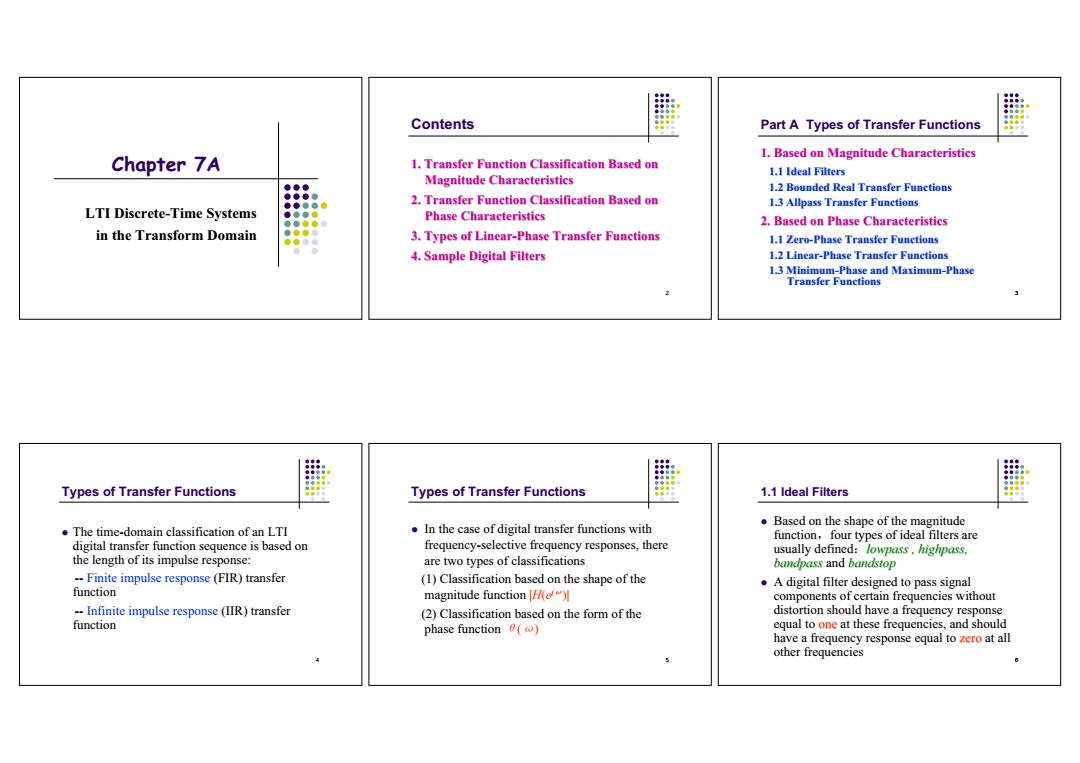正在加载图片...

Contents Part A Types of Transfer Functions 1.Based on Magnitude Characteristics Chapter 7A 1.Transfer Function Classification Based on ●●● Magnitude Characteristics 1.1 Ideal Filters 1.2 Bounded Real Transfer Functions 2.Transfer Function Classification Based on 1.3 Allpass Transfer Functions LTI Discrete-Time Systems Phase Characteristics 2.Based on Phase Characteristics in the Transform Domain 3.Types of Linear-Phase Transfer Functions 1.1 Zero-Phase Transfer Funetions 4.Sample Digital Filters 1.2 Linear-Phase Transfer Functions 1.3 Minimum-Phase and Maximum-Phase Transfer Functions Types of Transfer Functions Types of Transfer Functions 1.1 Ideal Filters In the case of digital transfer functions with Based on the shape of the magnitude The time-domain classification of an LTI function,four types of ideal filters are digital transfer function sequence is based on frequency-selective frequency responses,there usually defined:lowpass.highpass, the length of its impulse response: are two types of classifications bandpass and bandstop --Finite impulse response(FIR)transfer (1)Classification based on the shape of the A digital filter designed to pass signal function magnitude function ( components of certain frequencies without --Infinite impulse response (IIR)transfer (2)Classification based on the form of the distortion should have a frequency response function phase function ( equal to one at these frequencies,and should have a frequency response equal to zero at all other frequencies 5Chapter 7A LTI Discrete-Time Systems in the Transform Domain 2 Contents 1. Transfer Function Classification Based on 1. Transfer Function Classification Based on Magnitude Characteristics Magnitude Characteristics 2. Transfer Function Classification Based on 2. Transfer Function Classification Based on Phase Characteristics Phase Characteristics 3. Types of Linear 3. Types of Linear-Phase Transfer Functions Phase Transfer Functions 4. Sample Digital Filters 4. Sample Digital Filters 3 Part A Types of Transfer Functions 1. Based on Magnitude Characteristics 1. Based on Magnitude Characteristics 1.1 Ideal Filters 1.1 Ideal Filters 1.2 Bounded Real Transfer Functions 1.2 Bounded Real Transfer Functions 1.3 Allpass Allpass Transfer Functions Transfer Functions 2. Based on Phase Characteristics 2. Based on Phase Characteristics 1.1 Zero-Phase Transfer Functions Phase Transfer Functions 1.2 Linear-Phase Transfer Functions Phase Transfer Functions 1.3 Minimum-Phase and Maximum-Phase Transfer Functions Transfer Functions 4 Types of Transfer Functions The time-domain classification of an LTI digital transfer function sequence is based on the length of its impulse response: -- Finite impulse response (FIR) transfer function -- Infinite impulse response (IIR) transfer function 5 Types of Transfer Functions In the case of digital transfer functions with frequency-selective frequency responses, there are two types of classifications (1) Classification based on the shape of the magnitude function |H(ej¹)| (2) Classification based on the form of the phase function ©(¹) 6 1.1 Ideal Filters Based on the shape of the magnitude functionˈfour types of ideal filters are usually defined˖lowpass lowpass , highpass highpass, bandpass bandpass and bandstop A digital filter designed to pass signal components of certain frequencies without distortion should have a frequency response equal to one at these frequencies, and should have a frequency response equal to zero at all other frequencies����